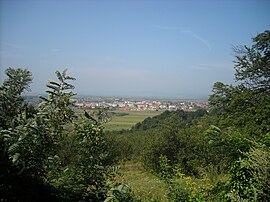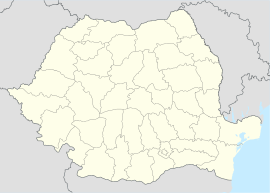world.wikisort.org - Romania
Hațeg (Romanian pronunciation: [ˈhat͡seg]; German: Wallenthal; Hungarian: Hátszeg) is a town in Hunedoara County, Romania with a population of 9,340. Three villages are administered by the town: Nălațvad (Nalácvád), Silvașu de Jos (Alsószilvás), and Silvașu de Sus (Felsőszilvás). It is situated in the historical region of Transylvania.
This article may be expanded with text translated from the corresponding article in Romanian. (April 2014) Click [show] for important translation instructions.
|
Hațeg | |
|---|---|
Town | |
 Hațeg panorama | |
 Location in Hunedoara County | |
 Hațeg Location in Romania | |
| Coordinates: 45°36′27″N 22°57′0″E | |
| Country | Romania |
| County | Hunedoara |
| Government | |
| • Mayor (2020–2024) | Adrian-Emilian Pușcaș[1] (PNL) |
| Area | 64.33 km2 (24.84 sq mi) |
| Population (2011)[2] | 9,685 |
| • Density | 150/km2 (390/sq mi) |
| Time zone | EET/EEST (UTC+2/+3) |
| Vehicle reg. | HD |
| Website | primariehateg |

History
In 1765, while part of the Habsburg controlled Principality of Transylvania, the settlement was completely militarised and integrated into the Second Border Company of the First Border Regiment from Orlat, until 1851, when that unit was disbanded.
Geology
Țara Hațegului (the Hațeg Country) is the region around the town of Hațeg. The fossils found in the Hațeg area span over 300 million years of Earth's geologic history, showing tropical coral reefs and volcanic island in the Tethys Sea, dinosaurs, primitive mammals, birds, and flying reptiles (such as Hatzegopteryx, which was named for the region).
Hațeg Island was an island during the Cretaceous Period where a dwarf species of sauropod dinosaur, Magyarosaurus dacus, lived until their extinction at the end of the Cretaceous. Baron Franz Nopcsa published articles about these Mesozoic-era archosaurs on Hațeg Island. His studies led to his theory of insular dwarfism, the notion that "limited resources" on small islands can lead to a downsizing of the indigenous vertebrate animals.[3]
Demographics
According to the first ethnic census of 1850, the town had 1,194 inhabitants, 915 of them being Romanian, 92 Roma, 77 Hungarian, 62 German and 48 of other ethnicities.[4] According to the 2011 census, Hațeg had 9,685 inhabitants, of which 93.15% were Romanians, 1.6% Hungarians, 1,1% of other ethnicities and unknown for 4,14% of the population.[4]
| Year | Pop. | ±% |
|---|---|---|
| 1850 | 915 | — |
| 1880 | 1,808 | +97.6% |
| 1900 | 2,367 | +30.9% |
| 1912 | 3,124 | +32.0% |
| 1930 | 3,383 | +8.3% |
| 1948 | 3,210 | −5.1% |
| 1956 | 3,853 | +20.0% |
| 1966 | 5,631 | +46.1% |
| 1977 | 8,423 | +49.6% |
| 1992 | 11,616 | +37.9% |
| 2002 | 12,507 | +7.7% |
| 2011 | 9,685 | −22.6% |
| Source: Census data | ||
Natives
- Nicholas Deak
- Chike Onyejekwe
- Nneka Onyejekwe
Gallery
- European bison in Hațeg nature reserve
- The I. C. Brătianu National College
- Saint Nicholas Orthodox Church
- Historic bank building, today Hotel Ferdinand
- Reformed Church
- Synagogue
- Nalatzi-Fay Manor, Nălațvad
- Trajan's Road near Hațeg (1900-1920)
- Interior of the Greek-Catholic Church (1900-1920)
See also
- Hateg Country Dinosaur Geopark
References
- "Results of the 2020 local elections". Central Electoral Bureau. Retrieved 8 June 2021.
- "Populaţia stabilă pe judeţe, municipii, oraşe şi localităti componenete la RPL_2011" (XLS). National Institute of Statistics.
- Csikia, Z.; M. J. Bentonb (2010). "An island of dwarfs — Reconstructing the Late Cretaceous Hațeg palaeoecosystem". Palaeogeography, Palaeoclimatology, Palaeoecology. 293 (3–4): 265–270. doi:10.1016/j.palaeo.2010.05.032.
- "ERDÉLY ETNIKAI ÉS FELEKEZETI STATISZTIKÁJA" (PDF).
External links
 Hațeg travel guide from Wikivoyage
Hațeg travel guide from Wikivoyage- Hațeg City Hall Official Site (in Romanian)
На других языках
[de] Hațeg
Hațeg (deutsch Hatzeg oder Hötzing, ungarisch Hátszeg) ist eine Kleinstadt im Kreis Hunedoara in Rumänien.- [en] Hațeg
[ru] Хацег
Хацег (рум. Hațeg, венг. Hátszeg, нем. Hatzeg, Hötzing) — город в Румынии в составе жудеца Хунедоара.Другой контент может иметь иную лицензию. Перед использованием материалов сайта WikiSort.org внимательно изучите правила лицензирования конкретных элементов наполнения сайта.
WikiSort.org - проект по пересортировке и дополнению контента Википедии










